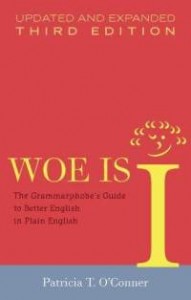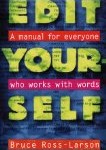“The Which Trials” according to “Woe is I”

If you’ve ever worried whether to use “which” or “that” you’re not alone. It took me years to figure out. However, Patricia O’Connor lays out the rules nicely in “The Which Trials” section of her book, Woe is I: The Grammarphobe’s Guide to Better English in Plain English.
Which vs. that
Here are O’Connor’s rules from page 3 of her book.
- If you can drop the clause and not lose the point of the sentence, use which. If you can’t, use that.
- A which clause goes inside commas. A that clause doesn’t.
Investment commentary example
I grabbed a sentence from a John Mauldin commentary to illustrate O’Connor’s rules for using which. In “A Player to Be Named Later,” he wrote, “The carrot is 1% financing for your banks, which can then buy your bonds at 4-5-6% (depending on the country).”
Which is proper in this sentence because the following sentence makes sense: “The carrot is 1% financing for your banks.” Mauldin properly places a comma before the start of the which clause.
Here’s a Mauldin sentence that properly uses that: “Will those lines look like the one that Colonel Travis drew with his sword at the Alamo, where those who crossed and joined him knew their fate?” A sentence consisting only of “Will those lines look like the one?” doesn’t make sense. Thus, that is required.
The first sentence of Mauldin’s commentary requires a judgment call about whether the second clause is essential to the meaning of the sentence. It says, “We have come to the end of yet another European Summit that was supposed to be the one to fix the problem.” The shortened version of the sentence–“We have come to the end of yet another European Summit”–works, suggesting which should replace that. However, it seems important to me that the summit failed to fix the problem. Without that phrase, the meaning of the sentence would change. Thus, it satisfies O’Connor’s stipulation that without the that clause you would “lose the point of the sentence.”
You’ll find more on these rules in “Which Versus That” by Grammar Girl Mignon Fogarty, one of my favorite online grammar resources. For a more technical explanation, see “Introduction and General Usage in Defining Clauses” on the Purdue Online Writing Lab site.
By the way, I wish Mauldin hadn’t capitalized “Summit.” But that’s a whole other issue, which I’ve explored in “Do you use ‘pride capitals’?”
Woe is I is a fun read
I recommend O’Connor’s Woe is I as a fun read. Plus, you may learn something from it. I know I did. I’m glad I learned about it from a post on the Copyediting Facebook page.


Oh, yeah — the which/that thing is a mistake I often see. This looks like a great book! Thanks for sharing it.
Thank you, Robyn!
The author has a great sense of humor about grammar and usage issues, so I think you’ll enjoy her book.
Susan,
Patricia O’Connor’s “which/that” rules may suffice in many instances. Many others, however, require the more traditional dependent/independent clause rules we learned in school. Thanks for providing links to sources that explain them.
As an example, I took particular note of your “summit” sentence. It’s useful because either “that” or “which” may be correct, depending on the writer’s intent. That is:
Was the problem expected to be fixed in previous summits? If so, “that” is correct.
Was this one the first summit to have that expectation? In that case, “which” is correct.
One related peeve: Many business writers are inconsistent (sometimes within the same piece) in their choice of “which” vs. “who” or “whom” to begin dependent and independent clauses. This is a flaw most often noticed by those who write in other languages, where the choice requires a selection among many gender-based alternatives.
It’s important to learn and follow the standard your style manual suggests in making the choice. In most cases, that choice should mirror your choice of second-reference pronouns.
Thank you, Phil. I agree with you about consistency in pronouns and in usage generally.